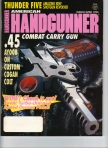Fall in Arizona, the camaraderie of silhouette shooters, automatic target setters, and the opening of quail season. Like the beer commercial says. “It doesn’t get any better than this!”
And more than 180 entries in the IHMSA Field Pistol Championship match sampled this taste of Utopia at the Tucson Rifle Club last October.
There’s not enough poet in me to adequately describe the beauty of October in southern Arizona, or the warm feelings that accompany a gathering of old friends and handgunners. so I’ll skip the schmaltz and get to the basics.
Suffice it to say. if you get a chance to combine a fall vacation trip to Arizona with a silhouette match at any of the clubs from Phoenix to the Mexican border, jump on it!
Those of you who attended the long range International Championship match in Tennessee saw the pneumatically powered target setters in action on the .22 targets, but this was my first exposure to the system, and the first time it had been used on big bore targets, albeit half scale field pistol size. Designed and manufactured by IHMSA’s Vice President Gary Wrigley. it performed beautifully!

The Tucson system was set up so that all targets were reset (and clamped, if necessary, during periods of high winds) from the range master’s station on the firing line.
There were some instances of “pilot error” where the range master forgot to retract the target setting bar that also acts as the target clamping device, but there were absolutely no malfunctions of the mechanical or pneumatic systems.
The compressor is the only noisy element in the system, so it’s best to locate it somewhere off the firing line. Interestingly, the Tucson guys put the compressor in the men’s restroom where its unanticipated start-ups throughout the match injected some sudden excitement into the morning meditations of several participants!
There are some huge advantages in the use of the new automatic system. First, is the reduction in the amount of recurring labor cost to put on a match. Instead of the usual number of target setters, this match used a maximum of four people to paint targets, and that was only after every other five shot string.
This allows more shooters per bank of targets due to the accelerated time table. You might hear a little grumbling about going too fast at the first couple of matches, but shooters will adjust to newly learned timetables.
And in the event of wind knocking targets over, clamping or unclamping targets is achieved with the push of a button, so there are no more long delays or agonized decisions over what to do.
Gary is working on an up-sized system to handle full-size, big bore targets and hopes to have one operational soon. From what I saw at Tucson, I expect nothing less than total success. Giant kudos to Gary on his terrific innovation!
In an attempt to facilitate loading rimfire cartridges into the BF single shot, falling block pistol, long time silhouetter Lynn Hayes designed and built an extremely simple loading tool comprised of plastic tubing and wooden dowels.
Basically, the plastic tube holds the .22 round by the rim, and the wooden dowel slides down inside the plastic tube pushing the cartridge out of the tube and into the chamber when the tool is inserted into the breach of the BF. Lynn says it also works for the MOA pistol, and while I don’t think he’s offering these tools for sale commercially, you can probably build one just from the photograph.

For you stat buffs, 181 entries from 11 states competed using nine different brands of guns. Single shots were used in 83 percent of the matches with T/Cs and XLs dominating, but MOA and BF had hardware in all four different disciplines. Wheelguns and semi-autos made up the other 17 percent, with Browning having the edge in .22 events and the revolver manufacturers sharing the centerfire events.
Marvin Tannahill won three of the four events, Centerfire Scoped and Smallbore Open Sights by a respectable margin, but had to whup Mike Stimson in a shoot-off for Smallbore Scoped.
Bob Kelly won the Centerfire Open Sight outright, but with Tannahill and Stimson breathing heavily in hot pursuit. Marv’s dominance in the individual events made him aggregate champion across the board.
And as she has at so many silhouette matches, Lee Cottriel captured the Lady Two-Gun Hunter’s Pistol, Two-Gun Smallbore, and Four-Gun Aggregate Championships.
For information on the Automatic Target Setting system, you can contact Gary Wrigley at Gateway Hose and Coupling Co., Dept. AH, 246 E. Monroe, Kirk-wood, MO, 63122; phone: (314) 822-7400.
Published: American Handgunner – March/April 1994

